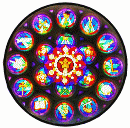PETERS, Rev. Samuel D.D.: 1735 - 1826
Samuel Peters was born in 1735 in Connecticut, the third child of John Peters and Mary Marks. He graduated from Yale University in 1757, and served as rector of St. Peter’s Church, Hebron, Connecticut. In 1758 he travelled to England, was ordained as a deacon in the Protestant Episcopal Church and advanced to the priesthood. He returned to Hebron in 1759. Reverend Peters evidently used his pulpit to voice his Loyalist sympathies and was threatened by the Sons of Liberty with tar and feather and a ride on a rail to the village green. He retreated to Boston and then sailed to England in 1774.(1) His extensive estates were confiscated.
Samuel married three times. He was first married to Hannah Owen and after her death to Abigail Gilbert. His third wife was Mary Birdseye. There were two children as a result of these marriages: Hannah Owen Peters (1763 - 1845) and William Birdseye Peters (1774 - 1822).
Samuel was once again a widower when he left for England in 1774. During his exile, he lived in London with his daughter Hannah and they were joined later by Samuel’s son, William, who had initially been left in America with his maternal grandparents. John Graves Simcoe, later to become Lieutenant Governor of Upper Canada, recommended Reverend Peters for the bishopric of Upper Canada without success. During his time in London, Samuel wrote A General History of Connecticut ... by a Gentleman of the Province, published in London in 1781. His Puritan ancestors had lived in the colony since the 1630’s and the book deals with early settlement and relations with the native population in the area that was to become the state of Connecticut. The book, which also referred to blue laws,(2) was unpalatable to the Connecticut colonists and was publicly burnt. Republished in 1877, it can be read online.(3)
Reverend Peters’ daughter, Hannah, married William Jarvis (Tile # 52) in 1785 in London. Jarvis had served under John Graves Simcoe during the Revolutionary War and when he was appointed Lieutenant Governor of Upper Canada in 1792, William Jarvis was appointed Provincial Secretary and Registrar on Simcoe’s recommendation. He and Hannah, accompanied by their children, resettled in Upper Canada.
Samuel returned from London to the United States in 1805. Although he wrote a book about his ancestor, the Reverend Hugh Peters, published in 1807,(4) he had no remunerative work. As was the case with so many other families, loyalties were divided during the Revolutionary War. A nephew, John Samuel Peters, later served as Governor of Connecticut from 1831 to 1833. Another nephew, John T. Peters, served as Justice of the Supreme Court of Connecticut from 1818 to 1834.(5) Reverend Samuel Peters did not profit from these connections and the venerable old man died in great poverty in New York, on April 29, 1826.
1. Allen, Thomas B., Tories: Fighting for the King in America’s First Civil War (New York: Harper Collins, 2010), Ch. 12, footnote #44, p. 389.
2. Laws that prohibit business on the Sabbath. Samuel Peters may have been the first to coin the term blue laws.
3. The Rev. Samuel Peters, DD, 1887, Cornell University Libraries, www.openlibrary.org.
4. Rev. Samuel Peters, DD, A History of the Rev. Hugh Peters (New York, 1807): “Rev. Hugh Peters, Arch. Intendant of Eng., 1640-60, found guilty of treason and executed for his zeal in Parliament”.
5. “Samuel Peters” www.wikipedia.org, accessed June 2011.

